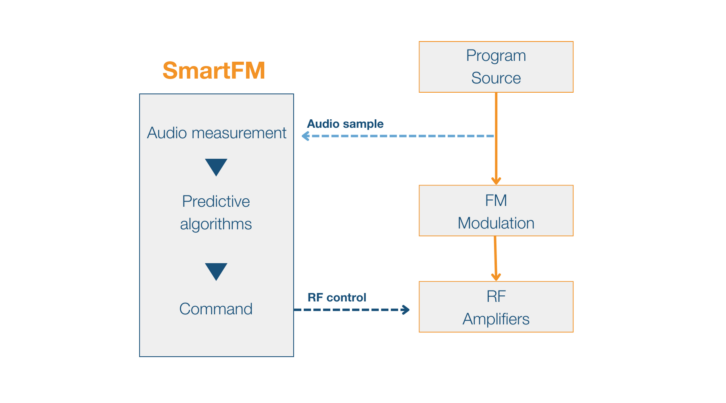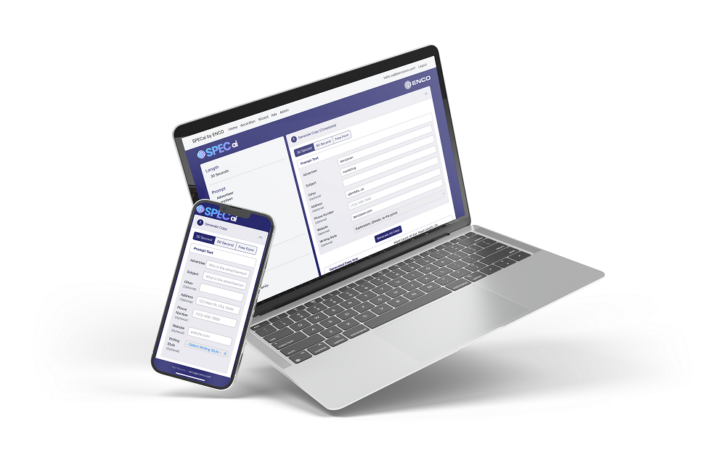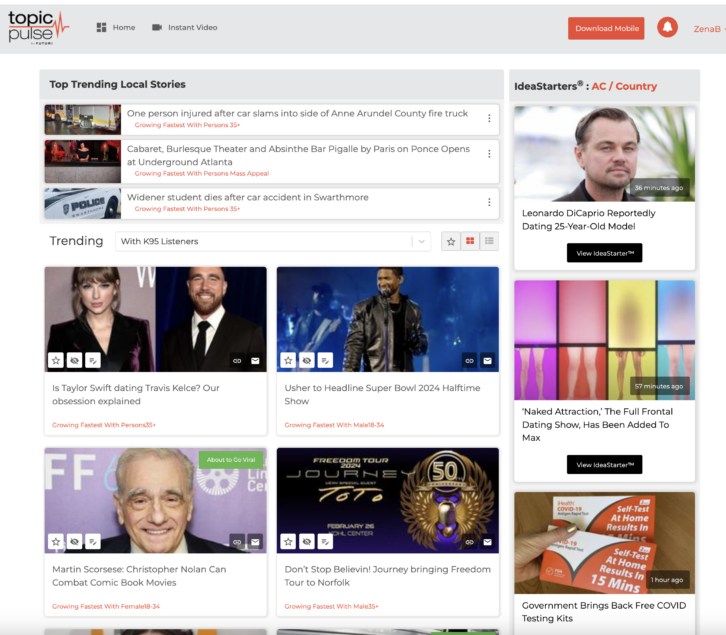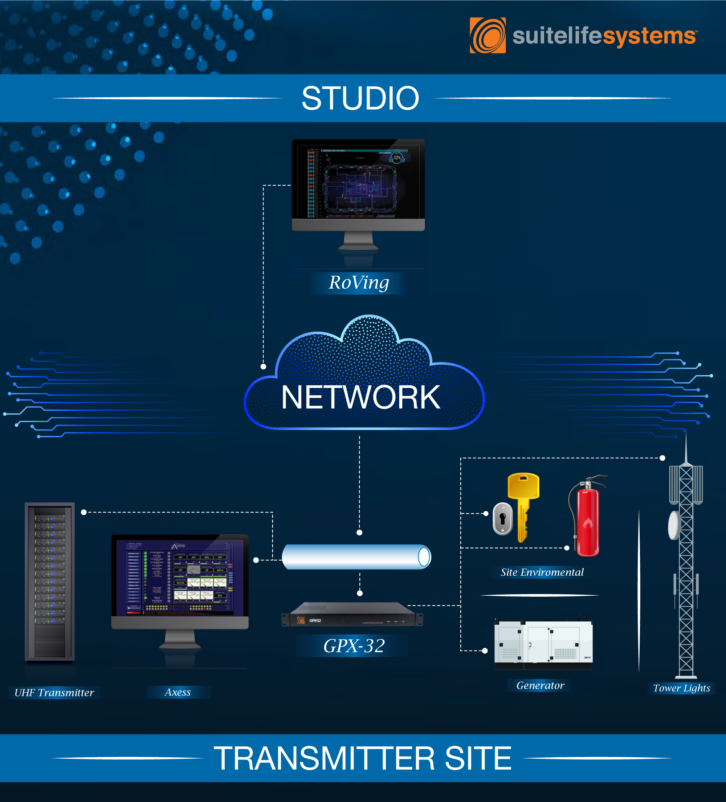The number of products and platforms for radio broadcasters based on some form of artificial intelligence technology is exploding. This feature provides an overview of 10 of them.
WORLDCAST SYSTEMS

While generative AI gets attention for its potential impact on creative work, AI already is being used behind the front panels of parts of the airchain already.
WorldCast Systems offers a technology called SmartFM on its Ecreso transmitters, which range in power levels from 100 Watts to 10 kW.
“SmartFM enables broadcasters to benefit from up to 40% energy savings on their FM transmission — this includes reducing electricity costs and lowering CO2 emissions — without any compromise on audio quality or coverage,” said Gregory Mercier, director of product marketing. He said a 10 kW FM using an Ecreso transmitter with SmartFM could save 824 MWh over 10 years compared to an older transmitter with 55% efficiency.
The tool predicts human perception of audio quality at the limit of coverage and depending on content characteristics. “After a psychoanalysis algorithm qualifies the robustness of audio content to perturbations, SmartFM dynamically changes the RF output power in relation to broadcast content.”
The AI has three steps. First it uses a statistical approach for content breakdown and classification. “This phase corresponds to the retrieval and analysis of large numbers of data, our ‘big data,’” Mercier said. This enabled WorldCast to create a library of audio content classified by signal characteristics as well as by the impact on the listener’s acoustic experience. The tool then uses a probabilistic approach in the implementation of content detection, and finally a deterministic approach in automating RF management.
SmartFM is sold as a software option with annual fee or a permanent license. Ecreso transmitters include a three-month free trial.
A notable user is Uplink Network GmbH in Germany. It deployed SmartFM across 800 Ecreso transmitters with the support of broadcasters including Deutschland Radio, RBB, WDR and NDR.
ENCO

SPECai, formerly called ENCO GPT, uses generative AI models to generate audio content and automate voice tracking and commercial creation for TV and radio workflows. It creates spec spots and commercials on demand to simplify radio production.
“SPECai shines by helping users to instantly create ad and promotion copy on behalf of sponsors, alleviating the time, energy and costs spent with traditional methods,” said President Ken Frommert.
“An intuitively designed web interface allows users to run it from anywhere with an internet connection, including mobile browsers.”
The user answers a few questions to generate copy for a 15-, 30- or 60-second ad. A text window presents the copy, which users can manually edit or re-generate.
Next, the user selects the most appropriate voice from several male or female voice options available. SPECai then allows the user to add the right music bed for the spot before downloading the final down-mixed audio file.
“Spec ads can be downloaded and sent to the client almost immediately,” Frommert said.
“The user interface is simple enough for users of any skill level to learn quickly, with intuitive prompts that guide users through the process.”
SUPER HI-FI

Super Hi-Fi products are based on an AI production technology called MagicStitch, said Chief Commercial Officer Ryan Taylor.
The headliner product is Program Director, an “operating system” that Taylor says enables broadcasters to curate, program, schedule and operate their stations.
“AI powers all of the audio production, like creating segues, layering in voice tracks and branding, volume leveling and more. AI also powers our clock rotations, automatically selecting songs that sound good together and separating out music throughout the day.” Program Director is sold for a monthly platform or per-station fee.
The company also has Weathercaster, an automated service that can create weather reports using custom synthetic voices, produced with openers, sponsorships and music beds, and created in various lengths. The AI generates scripts, creates voices, assembles elements and produces the output. Weathercaster is offered in tiers starting at $199 per month per station.
And VoiceIQ, part of Program Director, is a cloud-based AI that prepares and delivers produced voice tracks. Taylor said they sound as if they were edited and mastered manually. It removes background noise, tone-matches to the user’s reference standard, eliminates plosives and clipping and optimizes dynamic range.
Super Hi-Fi’s audio and music selection/rotation AI was developed in house. The company uses ChatGPT for script creation and partners with ElevenLabs for voice synthesis. iHeartRadio is using MagicStitch for automated segues in its mobile apps on digital-only stations. Cardio equipment maker Peloton uses it on Peloton Radio and its “Scenic” rides. Sonos uses Program Director on its owned-and-operated stations.
FUTURI MEDIA

The company’s RadioGPT has gotten lots of headlines but that is only one of Futuri’s AI-based tools.
TopicPulse is an AI-driven story discovery and social content system. For show prep it promises “real-time insights on the stories that are currently trending with a specific audience, the stories that are about to go viral with that audience, and the stories that are getting stale so that content creators can avoid them.”
A companion product called TopicPulse Instant Video gives creators access to short video clips on that day’s hot stories, using licensed footage, that can be rebranded or edited with custom VO or images, and pushed to a station website and social feeds.
Spokeswoman Zena Burns said the AI is used to scan Facebook, Twitter/X, Instagram and a quarter of a million sources of news and information to deliver insights on how stories are performing with specific audiences. “AI is also used to create first drafts of social posts, blog posts and on-air talking points based on those stories.”
TopicPulse uses natural language processing and adaptive AI.
Futuri said the tool has thousands of users in radio, TV, digital publishing and other segments. Radio users include Audacy’s WXBK(FM) in New York and Hubbard’s WTOP and Howard University’s WHUR(FM), both in Washington.
Other tools from Futuri that rely on AI include SpotOn, Prep+, podcasting AI Post and revenue AI system TopLine.
WAYMARK

This video creation tool uses the website URL of a business to create “instant, fully customized and ready-to-air commercials.” It can be used to generate “spec” creative for potential ad partners for streaming and cable TV placements.
“Broadcasters find that this helps them from spec all the way to air; they can win more ad revenue and/or extend campaigns with local businesses,” said CEO Alex Persky-Stern.
“Our partners consistently report that Waymark helps open doors to businesses who otherwise would not have been able to afford video advertising packages.”
The platform uses AI for multiple stages of the video creation process. It incorporates large language models for scriptwriting, computer vision models for image curation and selection, upscaling models for asset enhancement, and text-to-speech technology for synthetic VOs. “Waymark leverages a fine-tuned model of GPT-3, as well as a proprietary combination of 12 other AI technologies.”
The company partners with stock libraries to ensure that its assets are licensed, and the AI models rely on images and videos that are already in use by the user’s brand.
Waymark is a scalable subscription-based service. Partners can choose monthly or annual payment plans. Radio clients include Alpha Media Group, Beasley Media Group and Morgan Murphy Media.
RADIO.CLOUD

From Radio.Cloud comes Voicetrack.ai, which is used to create hosted radio shows with an AI DJ.
“Voicetrack.ai allows a fully automated AI supported operation of a hosted 24/7 channel or complete radio shows, such as overnights or weekends,” said Managing Director/CEO Christian Brenner.
“The AI host will perform similarly to what a real DJ would do: music teasing, weather forecast, local stories, news, traffic reports, music chart updates, etc.”
AI creates the text for each voice break, creates DJ audio from a cloned voice and mixes the voice track into the show and playlist, including ramps and hook promos.
“We developed a complex backend and created the prompts we send to ChatGPT or Google Bard before checking and improving the reply,” Brenner said. “The Text-to-Speech is third-party.” Brenner called it “a real automated operation. We have heard that other products still require a lot of day-by-day manual work.”
The tool is sold as a monthly SaaS service, with cost varying depending on how many stations and how many hours per day are used.
In July Radio.Cloud helped launch Absolut Radio AI, believed to be the first 24/7 internet radio station fully driven by AI; the host, named kAI, informs listeners about AI and the voice tracks, imaging and playlist mixing are done by AI. Then in August, Absolut Radio AI debuted on DAB+, believed to be the first OTA station driven full-time by AI.
RADIO WORKFLOW

This is a web-based traffic platform that incorporates AI to generate creative elements for ad production. This includes voiceovers, voice cloning and generation, production music, sound effects and script writing.
Founder Shane Zammit said, “The AI component focuses on generative functions for ad production, including creating unique voiceovers through voice cloning and voice generation, script writing based on the context and tone of the ad segment, and generating production music and sound effects that fit the narrative.”
Zammit said Radio Workflow uses a mixture of AI models, including some developed in-house as well as open-source models and other external ones. “This hybrid approach allows us to offer a robust and versatile set of generative features tailored for radio ad production.”
The platform is available through a monthly model, with pricing tiers based on size and needs of the station.
Regional Media is among its users. “They have reported a significant improvement in the speed, productivity and creativity of their ad productions, attributing it to our AI-driven generative features,” Zammit said.
SUITELIFE SYSTEMS

SuiteLife Systems software helps broadcasters monitor infrastructure in and from studios and remote transmission sites. Its flagship product is Axess.
“It’s a logic engine that enables a centralized engineering team to monitor, control, manage and diagnose hardware and transmission infrastructure and facilities around the United States,” said Bobby Stevens, director of media technology sales and marketing.
“This includes monitoring for a site’s vital technical information including temperature, line pressure, RF Line (forward and reflective power), as well as the weather and outside environmental influences.”
The software provides cross-platform support for hardware and software systems made by various manufacturers. Axess logs data and creates instructions to notify engineers of changes in the state or function of infrastructure at their sites.
The engine uses SuiteLife Control Language to analyze hardware throughout a network. Data and information that are gathered are moved into an optical visual interface to be viewed on a dashboard. Axess notifies the broadcaster if systems are showing errors or are out of norm and logs the information. It can also be directed to make changes to hardware and RF transmission devices.
SuiteLife said Axess is used by major network affiliates and several large station groups, logging EAS and monitoring hundreds of sites and hardware.
VERITONE

Veritone developed an enterprise AI platform, aiWARE, that supports several offerings.
Veritone Discovery is a media discovery and analytics tool to discover large amounts of visual and audio broadcast data, and track and verify ads including organic mentions.
“By transforming broadcasts into intelligent, highly structured content in near-real time, customers can seamlessly find moments, brand mentions and other clips within seconds,” the company says. It provides the ability to search a broadcast for spoken words, faces, logos, objects and sentiments. Users include Audacy and Cox Media Group.
Veritone Attribute tracks performance of ads including tangible ROI data. It enables stations to optimize linear TV and radio campaigns by correlating an ad with web “lift” in nearly real time. Bonneville Seattle, Hubbard Broadcasting and Primedia are customers.
And Veritone Digital Media Hub is an asset management and monetization tool that enables stations to generate more revenue from their content.
“AI can uncover archival footage that can be shared, sold or otherwise used, speeding the path to content monetization. Additionally, AI makes it easy to organize, share and consolidate content with AI-driven metadata asset tagging, rights management controls and flexible integrations with current systems, ingesting AI into your current solution stack.” Users include CNN, Bloomberg and Westwood One.
ADTHOS

The Adthos Ad Platform can be used by broadcasters and clients to create targeted and voice-branded advertising and short-form audio content at a moment’s notice, the company says.
It uses AI to generate creative scripts. Text-to-speech adds the voicetrack using AI and synthetic voices, then the tool automatically selects music or sound effects to complete the audio ad, based on the context of the script generated.
Processes includes Voice Conversion, in which accent and pronunciation of the original speaker remain but it takes on the sound of the voice model; Overdubbing, in which a voice is instantly cloned and words in a sentence can be replaced, without training a voice model; Source Separation, in which music and voices can be separated into different tracks; Noise Removal, eliminating background noise; Speaker Separation, identifying individual speakers and separating them into tracks; and Content Moderation by the AI.
Adthos uses a combination of its own AI, open source with its own models, and external vendors. The company has approximately 70 trained voice models for broadcast purposes such as ads, news and sports.
An example of major users is Talpa Network in The Netherlands, which owns four national stations and sells airtime for four other national stations. Subscriptions start at just $49.95 per month for a basic package. A month’s free trial is available.
This year saw the launch of self-service audio ads. “Users simply submit a short briefing via the portal, and using AI technology, Adthos generates the script, adding AI voices, sound effects and music, resulting in a fully AI-produced ad that’s available to be played out instantly.”
For advertisers and smaller broadcasters, Adthos said, it saves time and cost of production, “while publishers can offer customers a self-service ad buying experience while supporting long-tail revenue streams through microtransactions.”
[Read More Radio World Stories About Artificial Intelligence]







